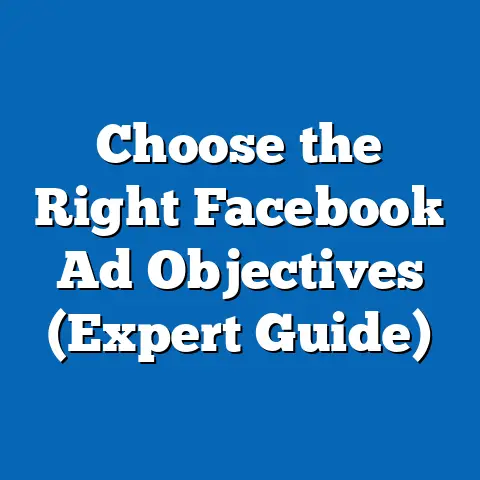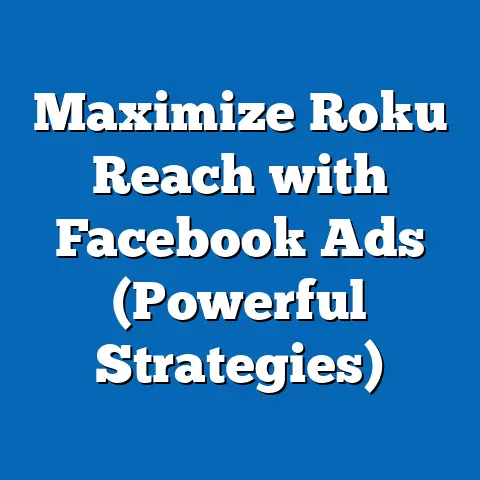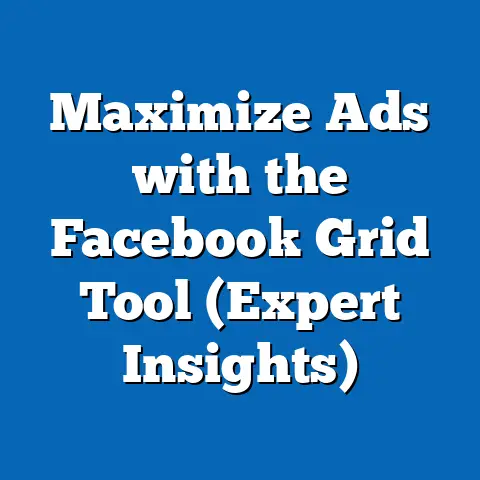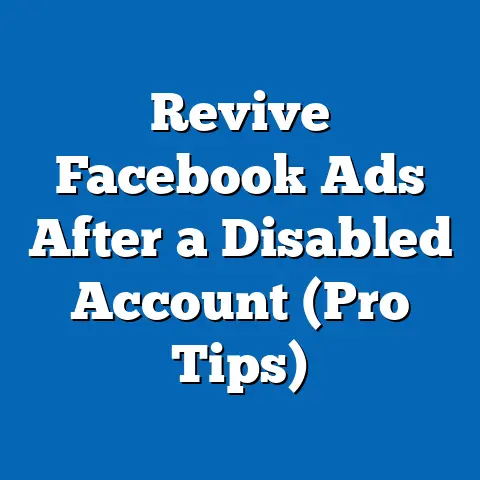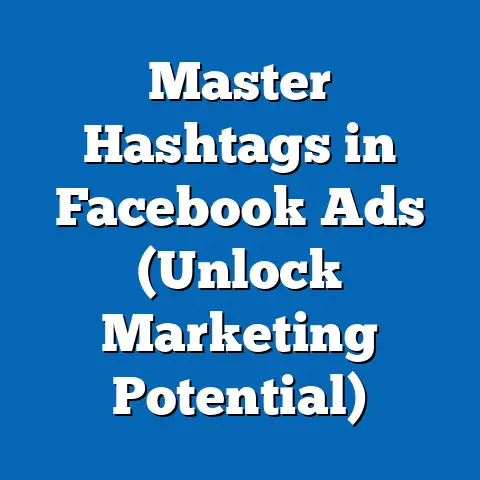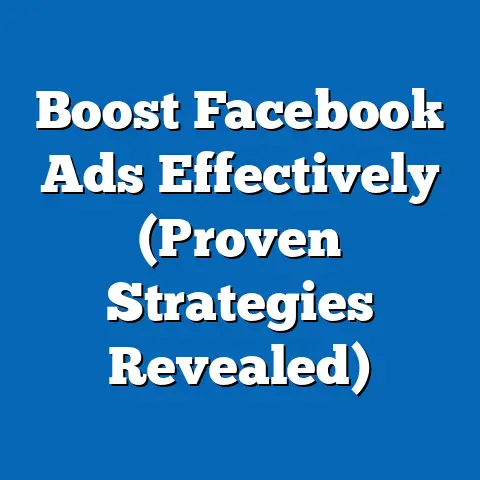Maximize Reach with Facebook Posts (Invaluable Strategies)
Have you ever scrolled through your Facebook feed and wondered why some posts skyrocket in popularity while others vanish without a trace? I know I have! It’s a question that’s plagued marketers and business owners for years. The truth is, understanding how to maximize your reach on Facebook is crucial for success, whether you’re building a brand, promoting a product, or simply trying to connect with your community.
Facebook, with its billions of users, remains a powerhouse for reaching a vast audience. But with so much content vying for attention, simply posting isn’t enough. You need a strategic approach. In this article, I’ll be diving deep into the invaluable strategies that will help you cut through the noise and get your Facebook posts seen by the people who matter most. From understanding the ever-changing algorithm to crafting engaging content and leveraging the power of Facebook Groups, I’ll equip you with the knowledge and tools to amplify your message and achieve your goals. Get ready to transform your Facebook strategy and watch your reach soar!
Understanding Facebook’s Algorithm
Ah, the Facebook algorithm. It’s the mysterious gatekeeper that decides which posts get seen and which ones are destined for digital oblivion. It’s a constantly evolving beast, and understanding its inner workings is the first step to maximizing your reach.
At its core, the algorithm aims to provide each user with the most relevant and engaging content possible. This means it analyzes a multitude of factors to determine what shows up in their News Feed. I’ve seen firsthand how a slight shift in the algorithm can dramatically impact a page’s reach, making it essential to stay informed and adapt your strategy accordingly.
Key Factors Influencing Reach:
- Engagement Rates: This is arguably the most critical factor. The more likes, comments, shares, and clicks your post receives, the more likely Facebook is to show it to more people. Think of it as a popularity contest where high engagement signals to Facebook that your content is valuable.
- Post Type: Facebook favors certain types of content over others. Videos, especially live videos, often receive higher priority in the News Feed compared to simple text updates. Images also tend to perform well, while links shared directly from your website might see a slight dip in reach due to Facebook wanting to keep users on their platform.
- Timing: Posting when your audience is most active is crucial. If you post when most of your followers are asleep, your post will likely get buried before they even wake up.
- Audience Targeting: The algorithm considers the interests and behaviors of your audience. If your post aligns with their preferences, it’s more likely to be shown to them.
- Relationships: Facebook prioritizes content from friends and family. As a business, you need to build relationships with your audience to increase the likelihood of your posts being seen.
The Algorithm’s Evolution & Impact on Organic Reach:
Over the years, Facebook has made numerous changes to its algorithm, often prioritizing personal connections over business pages. This has led to a significant decline in organic reach for many businesses. Back in the day, I could post something and expect a large percentage of my followers to see it organically. Now, that’s simply not the case.
According to recent statistics, organic reach for Facebook pages hovers around 5.2% of their total audience. This means that only a small fraction of your followers will see your posts without paid promotion.
Takeaway: Don’t rely solely on organic reach. Understanding the algorithm is essential, but it’s just one piece of the puzzle. You need to combine organic strategies with paid promotion to maximize your reach effectively.
Crafting Engaging Content
Even if you understand the algorithm perfectly, it won’t matter if your content is boring or irrelevant. Creating engaging content is the heart and soul of any successful Facebook strategy.
The Importance of High-Quality, Visually Appealing Content:
In today’s fast-paced digital world, attention spans are shorter than ever. You have mere seconds to capture someone’s interest as they scroll through their News Feed. That’s why visual appeal is so crucial. High-quality images and videos are much more likely to grab attention than a wall of text.
I’ve learned that investing in professional-looking visuals can make a significant difference in engagement. A well-designed graphic or a captivating video can stop someone in their tracks and entice them to learn more.
Different Types of Posts and Their Impact on Engagement:
- Videos: Videos are king on Facebook. They tend to generate higher engagement rates than other types of content. Short, attention-grabbing videos are particularly effective.
- Images: Eye-catching images are a close second. Use high-resolution photos that are relevant to your brand and audience.
- Links: Sharing links to your website or blog can drive traffic, but be mindful of how you present them. Use compelling descriptions and visuals to entice clicks.
- Text: While text-only posts might not be as visually appealing, they can still be effective for sharing quick updates, asking questions, or sparking discussions.
Tips on Storytelling and Crafting Compelling Captions:
Storytelling is a powerful way to connect with your audience on an emotional level. Share personal stories, customer testimonials, or behind-the-scenes glimpses into your business.
Here are some tips for crafting compelling captions:
- Keep it concise: Get to the point quickly.
- Ask questions: Encourage engagement by asking your audience for their opinions or experiences.
- Use emojis: Emojis can add personality and visual appeal to your captions.
- Include a call to action: Tell your audience what you want them to do (e.g., “Click the link below,” “Share this post,” “Comment with your answer”).
Takeaway: Content is king, but engaging content is emperor! Focus on creating high-quality, visually appealing content that resonates with your audience. Experiment with different types of posts and storytelling techniques to see what works best.
Leveraging Facebook Insights
You’ve created amazing content, but how do you know if it’s actually working? That’s where Facebook Insights comes in. This powerful analytics tool provides a wealth of data about your page’s performance, allowing you to track your progress and make informed decisions.
How to Utilize Facebook Insights:
Facebook Insights is your secret weapon for understanding your audience and optimizing your content strategy. I use it religiously to track what’s working and what’s not.
Key Metrics to Focus On:
- Reach: This metric tells you how many unique people saw your post. It’s a good indicator of your overall visibility.
- Engagement: This metric measures the total number of interactions your post received (likes, comments, shares, clicks). It reflects how engaging your content is.
- Click-Through Rate (CTR): This metric measures the percentage of people who clicked on a link in your post. It’s a good indicator of how compelling your call to action is.
- Audience Demographics: This section provides data about the age, gender, location, and interests of your followers. It helps you understand who you’re reaching and whether it aligns with your target audience.
Interpreting Metrics to Inform Future Posting Strategies:
Analyzing your Facebook Insights data can reveal valuable insights about your audience and content performance. For example:
- If you notice that videos consistently generate higher engagement rates than images, you might want to focus on creating more video content.
- If you see that your posts perform better at certain times of the day, you can adjust your posting schedule accordingly.
- If you find that a particular topic resonates strongly with your audience, you can create more content around that topic.
Takeaway: Facebook Insights is your data-driven guide to success. Use it to track your progress, identify trends, and optimize your content strategy for maximum reach and engagement.
Timing and Frequency of Posts
Timing is everything, especially on Facebook. Posting at the right time can significantly increase your reach and engagement.
Optimal Times and Days for Posting:
The best time to post on Facebook depends on your specific audience. However, there are some general guidelines that can help you get started.
According to various studies, the best times to post on Facebook are typically:
- Weekdays: Mid-morning to mid-afternoon (e.g., 9 AM to 3 PM)
- Weekends: Late morning (e.g., 10 AM to 12 PM)
These times tend to coincide with periods of increased activity on Facebook, as people check their feeds during breaks at work or school, or while relaxing at home on weekends.
Balancing Frequency and Quality:
While it’s important to post regularly, you don’t want to overwhelm your audience with too much content. Finding the right balance between frequency and quality is crucial.
I’ve found that posting too often can lead to a decrease in engagement, as people might start to tune out your content. On the other hand, posting too infrequently can cause your audience to forget about you.
A good rule of thumb is to aim for:
- Small businesses: 1-2 posts per day
- Larger businesses: 2-3 posts per day
Case Studies: Maximizing Reach Through Strategic Timing:
Many brands have successfully maximized their reach by strategically timing their posts. For example, a restaurant might post about lunch specials in the late morning, when people are starting to think about what to eat. Or a clothing retailer might post about new arrivals in the evening, when people are relaxing at home and browsing online.
Takeaway: Timing is key to maximizing your reach on Facebook. Experiment with different posting times to see what works best for your audience. Don’t overwhelm your followers with too much content, but post regularly enough to stay top-of-mind.
Harnessing User-Generated Content
User-generated content (UGC) is any content created by your customers or fans, rather than by your brand itself. It can include photos, videos, reviews, and testimonials. UGC is a goldmine for increasing reach and building trust.
Benefits of User-Generated Content:
- Increased Reach: When your customers share their experiences with your brand, their posts are seen by their friends and followers, expanding your reach exponentially.
- Enhanced Credibility: People are more likely to trust recommendations from their peers than from brands themselves. UGC provides social proof that your products or services are valuable.
- Cost-Effectiveness: UGC is essentially free advertising. You don’t have to pay for content creation; your customers are doing it for you.
Strategies for Encouraging UGC:
- Run contests and giveaways: Encourage people to share photos or videos of themselves using your products for a chance to win a prize.
- Create a branded hashtag: Encourage customers to use your hashtag when they share content related to your brand.
- Feature UGC on your page: Showcase the best UGC on your Facebook page to incentivize others to participate.
Examples of Brands Effectively Utilizing UGC:
Many brands have successfully leveraged UGC to amplify their reach. For example, GoPro regularly features videos shot by its customers on its Facebook page, showcasing the versatility and excitement of its products. Starbucks often reposts photos of its customers enjoying their coffee, creating a sense of community and belonging.
Takeaway: UGC is a powerful tool for increasing reach and building trust. Encourage your customers to share their experiences with your brand and feature their content on your Facebook page.
Engaging with the Audience
Facebook is a social platform, and engagement is key to success. Simply posting content isn’t enough; you need to interact with your audience, build relationships, and foster a sense of community.
Importance of Interaction and Community Building:
When you engage with your audience, you’re not just promoting your brand; you’re building relationships. People are more likely to support businesses that they feel connected to.
Strategies for Responding to Comments and Messages:
- Respond promptly: Don’t let comments and messages sit unanswered for days. Aim to respond within a few hours, or at least within 24 hours.
- Be authentic: Use a friendly and conversational tone. Avoid sounding robotic or generic.
- Answer questions thoroughly: Provide helpful and informative answers to questions.
- Acknowledge feedback: Thank people for their comments and suggestions, even if they’re negative.
- Take conversations offline: If a customer has a complex issue, offer to take the conversation offline via phone or email.
Successful Engagement Tactics Used by Popular Brands:
Many brands have mastered the art of engaging with their audience on Facebook. For example, Wendy’s is known for its witty and humorous responses to comments, often poking fun at its competitors. Netflix regularly asks its followers for recommendations and suggestions, creating a sense of collaboration and involvement.
Takeaway: Engagement is crucial for building relationships and fostering a sense of community on Facebook. Respond to comments and messages promptly, be authentic, and use creative tactics to spark conversations.
Utilizing Facebook Groups
Facebook Groups are communities centered around shared interests, hobbies, or goals. They can be a powerful tool for increasing reach and engaging with your target audience.
Role of Facebook Groups in Increasing Reach:
When you participate in a Facebook Group, your posts are seen by other members of the group, expanding your reach beyond your own page’s followers. Groups also tend to have higher engagement rates than pages, as people are more likely to interact with content in a community setting.
How Brands Can Create or Participate in Relevant Groups:
- Create your own group: If you have a strong brand identity and a loyal following, you can create your own Facebook Group to foster a sense of community and provide exclusive content to your fans.
- Participate in existing groups: Find groups that are relevant to your niche and actively participate in discussions, share valuable content, and answer questions.
Best Practices for Managing and Promoting Group Content:
- Establish clear guidelines: Set rules for the group to ensure that discussions remain civil and relevant.
- Moderate the group actively: Remove spam, inappropriate content, and members who violate the guidelines.
- Provide valuable content: Share exclusive content, behind-the-scenes glimpses, and helpful tips that are relevant to the group’s interests.
- Promote the group on your page: Let your followers know about your Facebook Group and encourage them to join.
Takeaway: Facebook Groups are a valuable tool for increasing reach and engaging with your target audience. Create your own group or participate in existing groups to connect with people who share your interests.
Paid Promotion Strategies
While organic reach is important, it’s often not enough to achieve your goals on Facebook. Paid promotion can significantly amplify your reach and target specific audiences.
Benefits of Facebook Ads in Conjunction with Organic Posts:
Facebook Ads allow you to reach people who aren’t already following your page, targeting them based on their demographics, interests, and behaviors. They can also help you boost the reach of your organic posts, ensuring that more of your followers see your content.
I’ve seen many businesses struggle with organic reach alone, and Facebook Ads can be a game-changer. They provide a level of targeting and control that organic methods simply can’t match.
Creating Targeted Ad Campaigns:
- Define your target audience: Identify the demographics, interests, and behaviors of the people you want to reach.
- Choose the right ad format: Select an ad format that is appropriate for your goals and target audience (e.g., image ads, video ads, carousel ads).
- Write compelling ad copy: Craft ad copy that is clear, concise, and persuasive.
- Include a strong call to action: Tell people what you want them to do (e.g., “Click here to learn more,” “Shop now,” “Sign up today”).
Insights into Budgeting, Audience Targeting, and Ad Formats:
- Budgeting: Start with a small budget and gradually increase it as you see results.
- Audience Targeting: Use Facebook’s targeting options to narrow down your audience and reach the people who are most likely to be interested in your products or services.
- Ad Formats: Experiment with different ad formats to see what works best for your goals and target audience.
Takeaway: Paid promotion can significantly amplify your reach and target specific audiences on Facebook. Use Facebook Ads in conjunction with your organic strategies to maximize your results.
Staying Updated with Trends
Facebook is a constantly evolving platform, and it’s important to stay informed about the latest trends and features. What worked last year might not work this year, so you need to adapt your strategies accordingly.
Importance of Staying Informed:
Staying informed about the latest trends and features on Facebook can help you stay ahead of the curve and maximize your reach. For example, if Facebook introduces a new ad format, you might want to experiment with it to see if it can improve your results. Or if the algorithm changes, you might need to adjust your content strategy to maintain your reach.
Adapting Strategies in Response to Platform Updates:
Facebook regularly releases updates to its platform, and these updates can sometimes have a significant impact on reach and engagement. It’s important to stay informed about these updates and adapt your strategies accordingly.
Resources for Keeping Up with Facebook Marketing News:
- Facebook’s official blog: This is the best source for news and updates about Facebook’s platform.
- Industry blogs: Many marketing blogs cover Facebook marketing news and best practices.
- Social media: Follow industry experts and thought leaders on social media to stay informed about the latest trends.
Takeaway: Facebook is a constantly evolving platform, so it’s important to stay informed about the latest trends and features. Adapt your strategies in response to platform updates and use reliable resources to stay up-to-date.
Conclusion
Maximizing reach on Facebook is an ongoing process that requires experimentation, analysis, and adaptation. By understanding the algorithm, crafting engaging content, leveraging Facebook Insights, optimizing your posting schedule, harnessing user-generated content, engaging with your audience, utilizing Facebook Groups, and using paid promotion strategies, you can significantly amplify your message and achieve your goals.
Remember, there’s no one-size-fits-all solution. What works for one business might not work for another. The key is to experiment, track your results, and adapt your strategies based on what you learn.
Now, I encourage you to apply these strategies to your own Facebook page and see what works best for you. And don’t forget to share your experiences in the comments below! I’m always eager to learn from others and help each other succeed in the ever-changing world of Facebook marketing. Let’s work together to unlock the full potential of Facebook and achieve our business goals!

